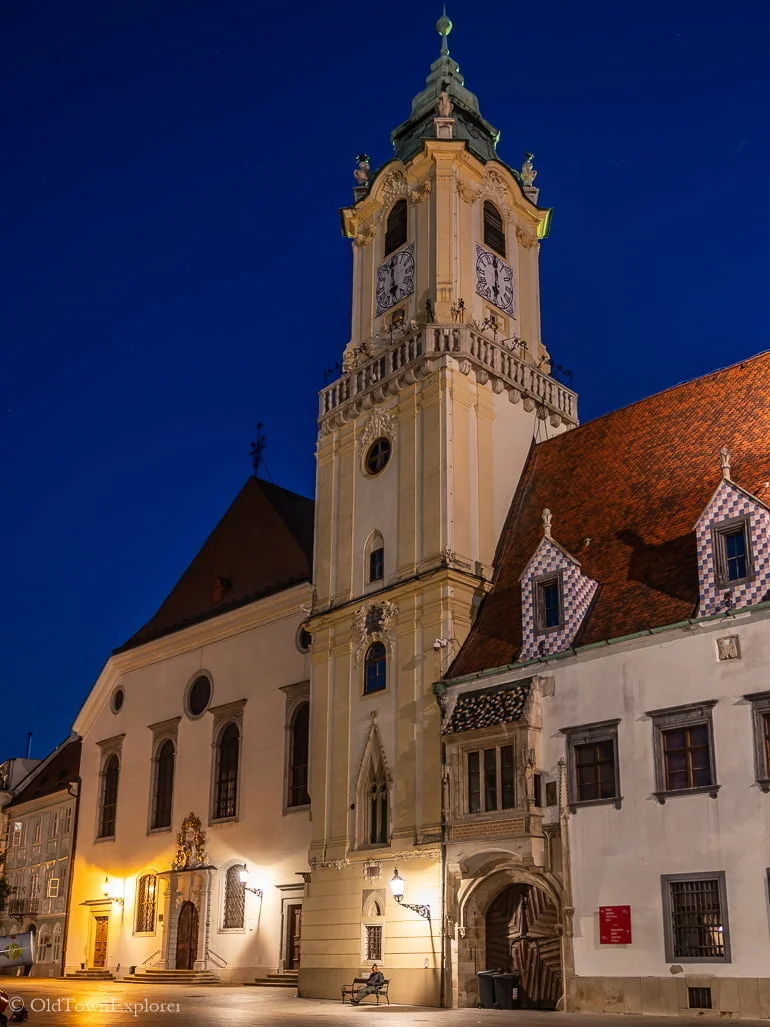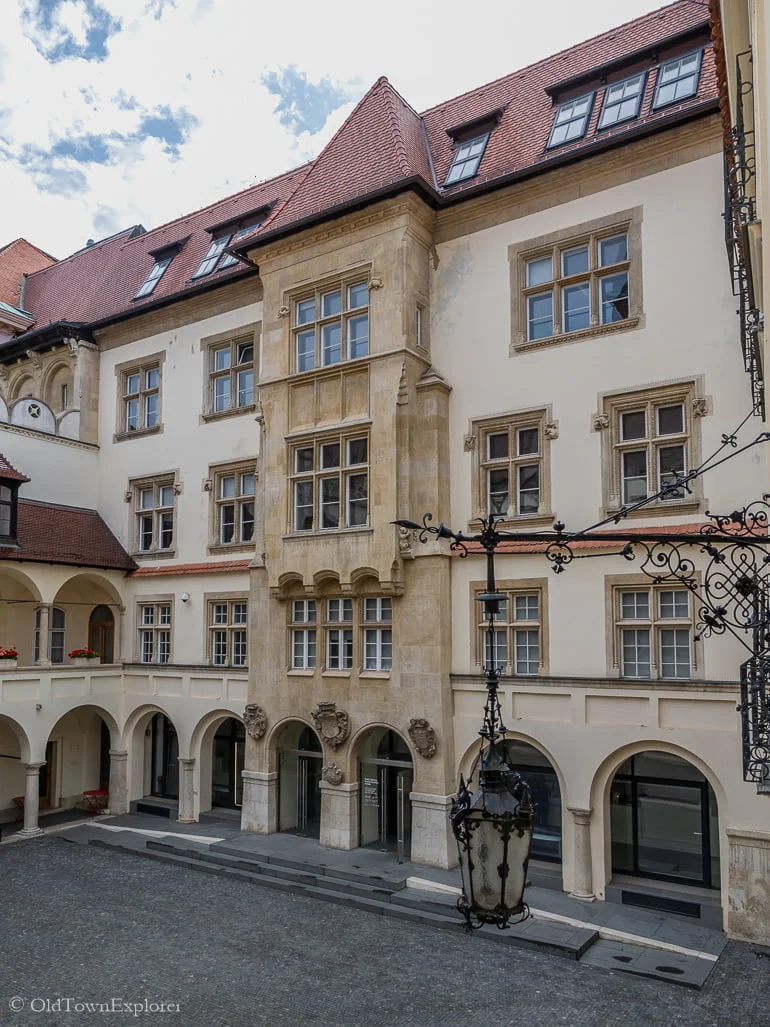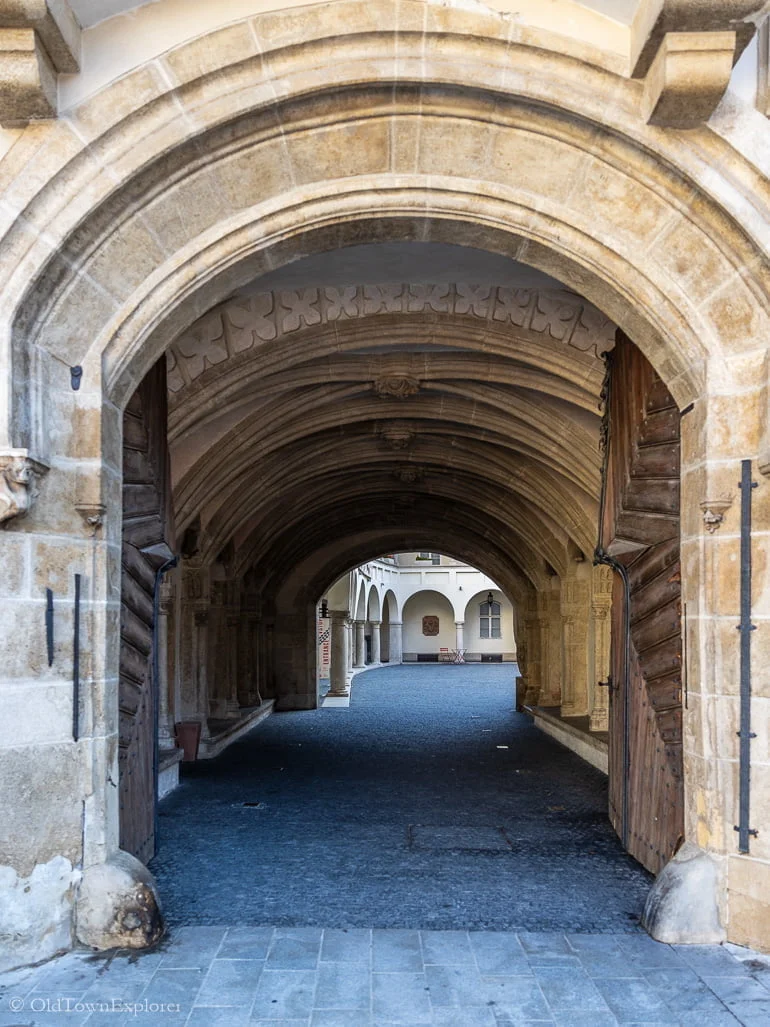What Are the Best Things to See in Bratislava?
Bratislava, Slovakia has many incredible sights and attractions. If you’re interested in architecture, the best things to see in Bratislava are:
- Bratislava Castle
- Old Town Hall
- Michael’s Tower
- The Blue Church
- Primacial Palace
- St. Martin’s Cathedral
- Grassalkovich Palace
- Reduta
- Church of the Elevation of the Holy Cross
- Slovak National Theatre
- Rubberneck (Čumil)
- Palace of the Hungarian Exchange Bank
- Church of the Most Holy Savior
- Church of the Annunciation
- Maximilian Fountain
- Temple of St. Nicholas
- Apponyi Palace
- The Trinity Catholic Church
- Schöne Náci
- Church of St. Elizabeth of Hungary (Alžbetínky)
- Vice Governor’s Palace
- Church of Our Lady of Loret
- Church of St. Stephan of Hungary
- Mirbach Palace
- The Church of the Visitation of the Virgin Mary (Merciful Brothers)
- Napoleonic Soldier
- Blumentálsky Church
- Fountain of St. George and the Dragon
- Church of St. Ladislaus
- Leopold De Pauli’s Palace
- Church of the Assumption of the Virgin Mary (Notre Dame)
- Slavín
- Kern House
We spent all of September visiting the sights in Bratislava. Based on our experience, we compiled this list of the best things to see.
If you don’t have a month to explore, you can follow our suggested Bratislava Walking Tour and easily see all the top things on our list in one day.
This website contains affiliate links that may earn us a small commission at no additional cost to you.
Best Things to See in Bratislava
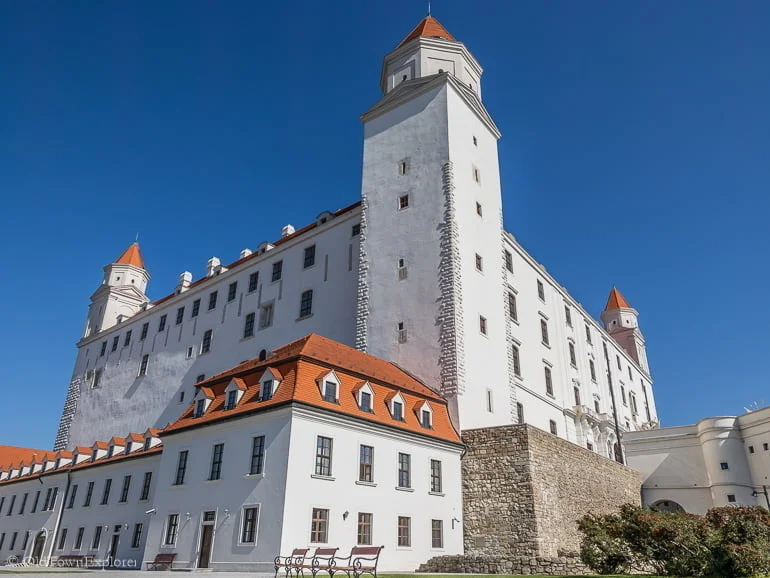
Bratislava Castle
Bratislava Castle is a prominent landmark in the city, situated on a hill overlooking the old town. The fortified settlement of “Oppidum” was established here by the Celts. Later, a Gothic-style castle was built as an anti-Hussite fortress during the reign of Sigismund of Luxembourg. In the 16th century, King Ferdinand ordered the castle to be rebuilt in the Renaissance style, and in the 17th century, it was rebuilt again, this time in the Baroque style. Since independence, the castle has served as a venue for the Slovak Parliament and houses collections of the Slovak National Museum.
Address: Hrad, 811 06 Bratislava, Slovakia
Old Town Hall
The Old Town Hall is a group of buildings in the Old Town district, consisting of structures dating back to the 14th century. This is the oldest city hall in Slovakia and one of the oldest stone buildings in Bratislava. The tower, which was constructed around 1370, is considered to be particularly noteworthy. Over the years, the town hall has undergone various modifications, starting with the joining of three townhouses in the 15th century.
Today, the buildings house the Bratislava City Museum, founded in 1868. This museum is the oldest in Bratislava and features exhibits that showcase the city’s history, including a display of torture devices. Additionally, visitors can view the Old Town and surrounding areas from the top of the Old Town Hall tower.
Address: Hlavné námestie 501/1, 811 01 Staré Mesto, Slovakia

Michael’s Tower
The copper roof of Michael’s Gate is a famous symbol of Bratislava, built in the mid-14th century. It was renovated between 1753 and 1758 in the Baroque style, becoming a well-known Gothic and Baroque monument. The tower stands 51 meters tall, with seven floors and an upper terrace that offers a magnificent view of the Old Town, making it one of the top tourist attractions in Bratislava. The tower features a statue of the archangel Michael slaying a dragon at the top.
To enter the tower, visitors must go through the Museum of Arms, which recently reopened after a long-awaited general renovation, and look for the replica cannon at ground level.
Address: Michalská ulica 22 806/24, 811 03 Staré Mesto, Slovakia

The Blue Church
The Church of St. Elizabeth of Hungary, also known as the Blue Church, is a beautiful Art Nouveau building in Bratislava. It was designed by Edmund Lechner, an architect from Budapest. The construction started in 1908, and the church was consecrated on October 11, 1913.
Its interior and exterior are adorned with blue majolica and painted in shades of pale blue. Even the roof is covered with blue-glazed ceramics. The structure boasts a 36.8-meter circular tower.
Address: Alžbety, Bezručova 2, 811 09 Bratislava

Primacial Palace
The Primate’s Palace, also known as Primacial Palace, is a neoclassical building in the Old Town. Built between 1777 to 1781, it was designed by architect Melchior Hefele. The palace’s facade is an excellent example of classical style. Inside, you’ll find the Hall of Mirrors and five salons named after the color of their walls. On the roof, there are allegorical statues and vases. The palace currently serves as the Mayor’s office.
Address: Primaciálne námestie 2, 811 01 Bratislava, Slovakia
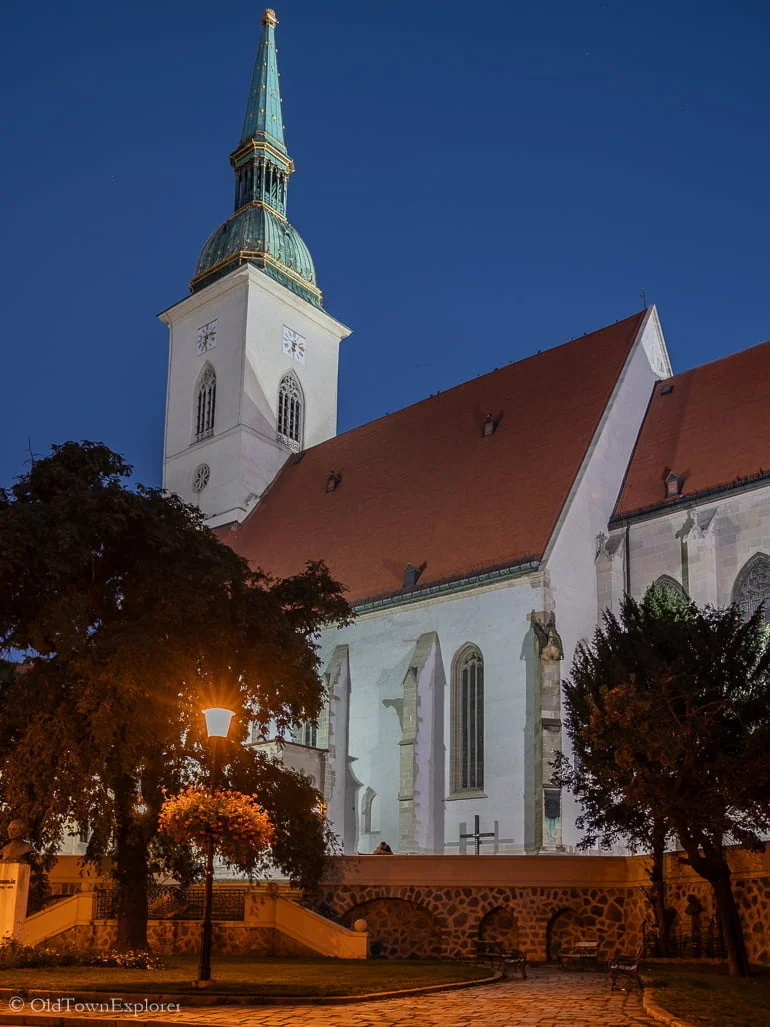
St. Martin’s Cathedral
St. Martin’s Cathedral is a three-nave Gothic cathedral located in Bratislava. The church was built on the site of a previous Romanesque church dedicated to the Holy Saviour in 1221. After Bratislava was given the privileges of a town in 1291, the church was rebuilt as part of the city walls, with its tower serving as a defensive bastion. The church was designed by architects Anton Pilgram, Jozef Lippert, and Ignác Feigler St. and consecrated in 1452.
The church’s interior is spacious and features a grand internal divided portal with a preserved tympanum and a relief of the Holy Trinity. The church has four chapels: the Canons’ Chapel, the Gothic Chapel of Sophia of Bavaria (widow of the Czech King Wenceslas IV), the Chapel of St. Anne, and the Baroque Chapel of St. John the Merciful. The portal of the southern antechamber is the oldest example of Renaissance architecture in Slovakia.
St. Martin’s Cathedral served as a coronation church for Hungarian kings and their consorts from 1563 to 1830. A 300-kg gilded replica of the Hungarian royal crown now sits on top of the cathedral’s 85-metre-tall neo-Gothic tower, marking its significance. In total, ten kings, one queen, and seven royal wives from the Habsburg Dynasty were crowned in St. Martin’s Cathedral.
Address: Rudnayovo námestie 1, 811 01 Bratislava

Grassalkovich Palace
The Grassalkovich Palace, also known as the Presidential Palace, was designed by the architect Anton Mayerhofe in the Baroque style and opened in 1760. It was originally built as a summer residence for Count Anton Grassalkovich, who served as the chairman of the Hungarian Royal Chamber and as an advisor to Empress Maria Theresa. The palace was a popular venue for aristocratic society events at that time. Nowadays, it is the official residence of the President of the Slovak Republic.
Address: Hodžovo námestie 2978/1, 811 06 Bratislava, Slovakia

Reduta
The Palais de Bratislava, which is also known as Reduta, is a magnificent building constructed in Baroque Revival style between 1911 and 1915. It replaced a granary that was originally built in the 18th century. The building was designed by D. Jakab and P. Komor, architects from Budapest.
Today, the Reduta is still used for lavish balls, and its concert hall is home to the Slovak Philharmonic Orchestra. It is also the venue for the annual Bratislava Music Festival.
Address: Mostová, 816 01 Bratislava, Slovakia

Church of the Elevation of the Holy Cross
The Church of the Elevation of the Holy Cross, also known as the Clarissine Church, was built in Gothic style starting in 1297. It is part of a group of medieval structures that formed the Convent of Poor Clares located in the Old Town. Nowadays, the city of Bratislava uses the church for cultural events.
Address: Klariská, 811 03 Staré Mesto, Slovakia
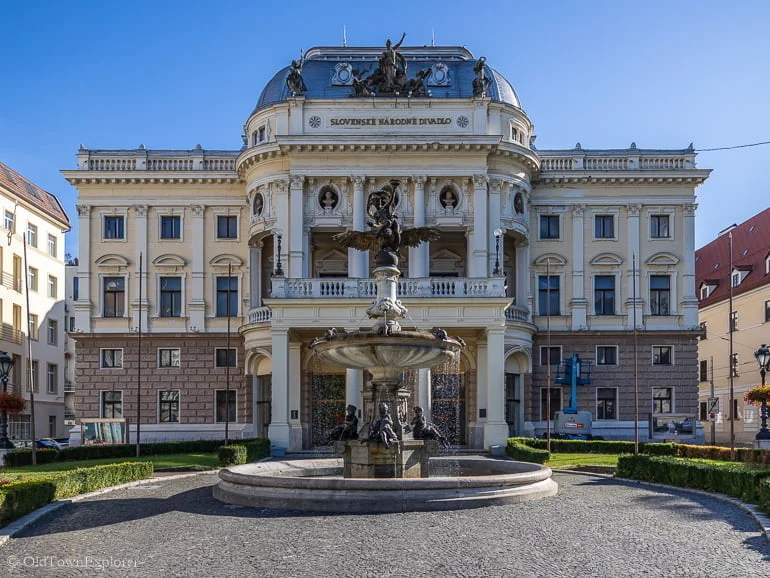
Slovak National Theatre
The Slovak National Theatre is a magnificent building in Neo-Renaissance style, which was originally opened in 1886 as the City Theatre. It was designed by two renowned Viennese architects, F. Fellner and H. Helmer.
The building’s façade features busts of several famous musical composers, and a stone sculptural group named the Muse of Thalia, which was created by the Viennese sculptor T. Friedl. Additionally, on the building’s façade, you can see putti figures of children that symbolize tragedy and comedy, created by V. Tilgner.
Address: Pribinova 17, Staré Mesto, Bratislava, Slovakia
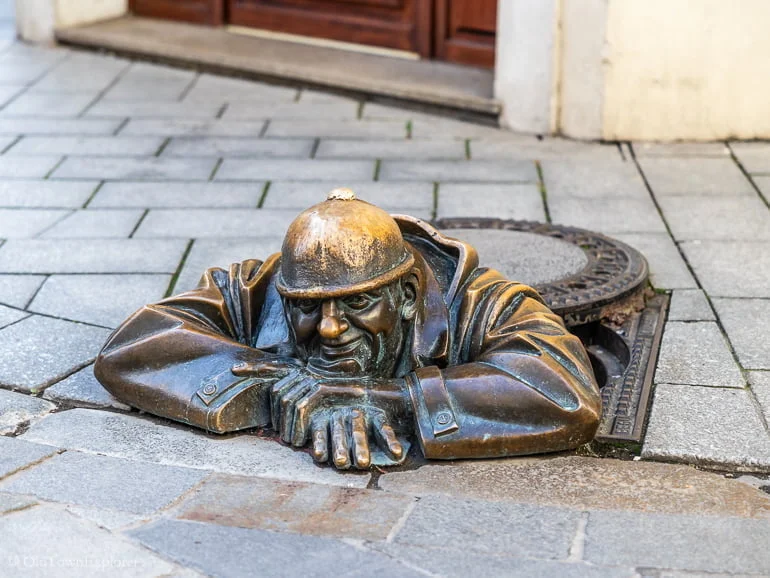
Rubberneck
Rubberneck (Čumil) is a unique bronze statue of a sewer worker resting at the top of a manhole. The statue was created by Viktor Hulík and was made on July 26, 1997. The statue is designed to look like the worker is “peeking” at people passing by. It is believed that touching the button on the cap of the statue brings good luck. This bronze statue of a handyman is placed in the middle of the street and is known to be the most photographed sculpture.
Address: Panská 251/1, 811 01 Bratislava, Slovakia

Palace of the Hungarian Exchange Bank
In 2018, restoration and modernization work began on the historic Palace of the Hungarian Exchange Bank (Uhorská eskontná a zmenárenská banka). Today, the building houses boutique office space.
Address: Hlavné námestie 356/5, 811 01 Staré Mesto, Slovakia
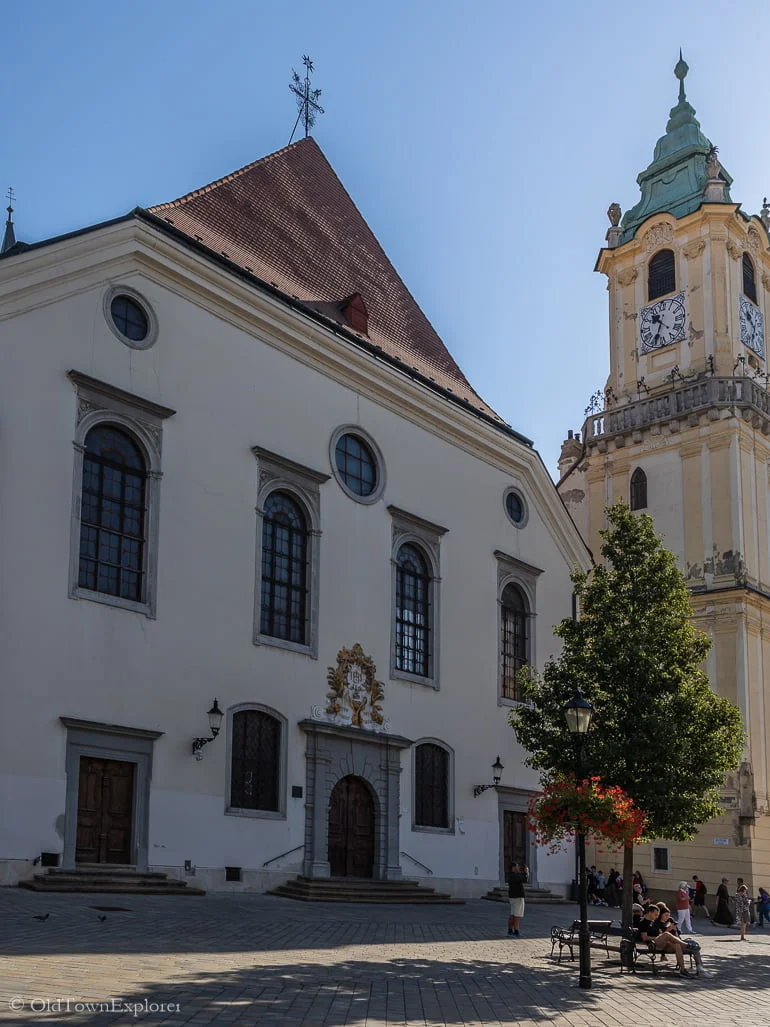
Church of the Most Holy Savior
The Holy Saviour Church, known as the Jesuit Church, was originally built in the 17th century as a Protestant church. Today, the Society of Jesus, commonly called the Jesuit Order, owns the church.
Address: Františkánske námestie, 811 01 Bratislava, Slovakia
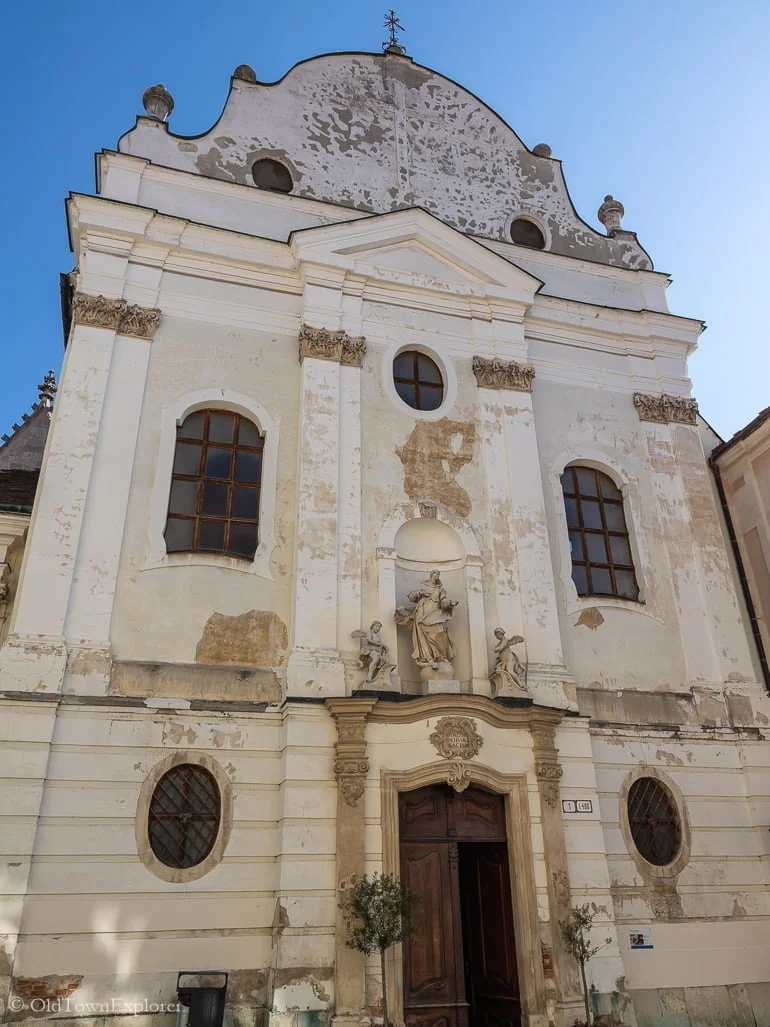
Church of the Annunciation
The Franciscan Church, built in Gothic style, is the oldest religious building in the Old Town. It was consecrated in 1297, and King Andrew III of Hungary graced the opening ceremony with his presence. This building was often used to host larger gatherings of the townspeople or the Hungarian nobles.
Address: Františkánske námestie 1, 811 01 Staré Mesto, Slovakia

Maximilian Fountain
The Maximilian Fountain, also known as Roland’s Fountain, is a famous landmark in the Old Town’s Main Square. It was constructed in 1572 by the Austrian sculptor Andreas Lutringer, on the orders of Hungary’s King Maximilian II, to provide the public with a water supply. The fountain features a statue of Maximilian, who is portrayed as a knight in full armor.
Over the years, the fountain has undergone several modifications and reconstructions, and its current appearance may differ from its original look. Nevertheless, it remains a popular meeting point for locals and tourists alike. Many legends revolve around the fountain, mostly featuring Maximilian as the protector of the town.
Address: Hlavné námestie, 811 01 Staré Mesto, Slovakia

Temple of St. Nicholas
St. Nicholas Church is an Orthodox church on the hill next to Bratislava Castle. It was constructed in 1661 on the orders of Countess Frances, widow of Paul Pálffy.
Address: Mikulášska 7277/5A, 811 01 Bratislava-Hrad, Slovakia
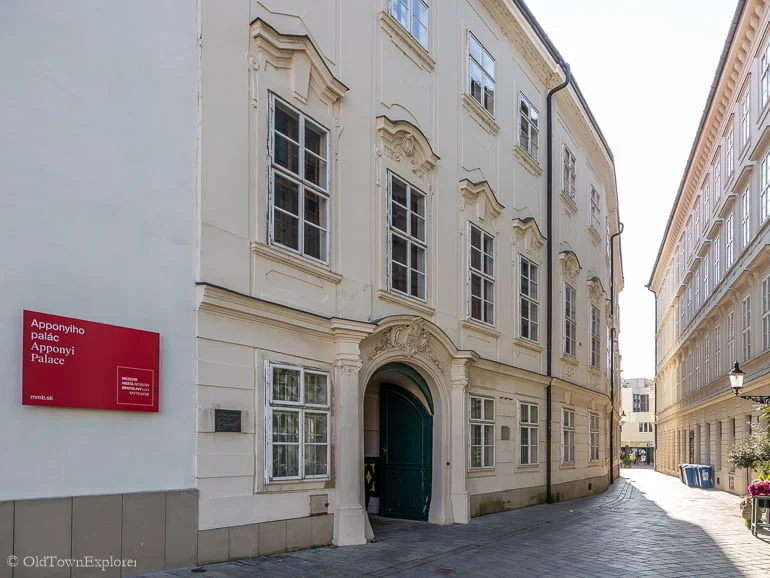
Apponyi Palace
The Apponyi Palace, which was constructed between 1761 and 1762, is located on the site of two old townhouses. Count György Apponyi, an advisor to the King of Hungary, built this palace. Later, the Bratislava municipality purchased it from the Apponyi family in 1867 and added its coat of arms above the street entrance.
Unfortunately, two of the palace’s original wings were demolished between 1910 and 1912 to make way for a new municipal building. However, the palace underwent extensive renovation between 2003 and 2007.
Address: Radničná 577/1, 811 01 Staré Mesto, Slovakia

The Trinity Catholic Church
The Holy Trinity Church is a Baroque-style Catholic church near Bratislava’s Old Town. Built in 1717 and consecrated in 1727, the church’s official name is the Church of Saint John of Matha and Saint Felix of Valois.
Significant features include a large main altar, side altars, and a prominent dome decorated with frescos by Antonio Galli da Bibiena. The church also has large statues of St. Agnes and St. Catherine of Alexandria by Johann Baptist Straub and an elaborate side altar commissioned by Count Zichy.
Address: Župné námestie 11, 811 03 Bratislava, Slovakia
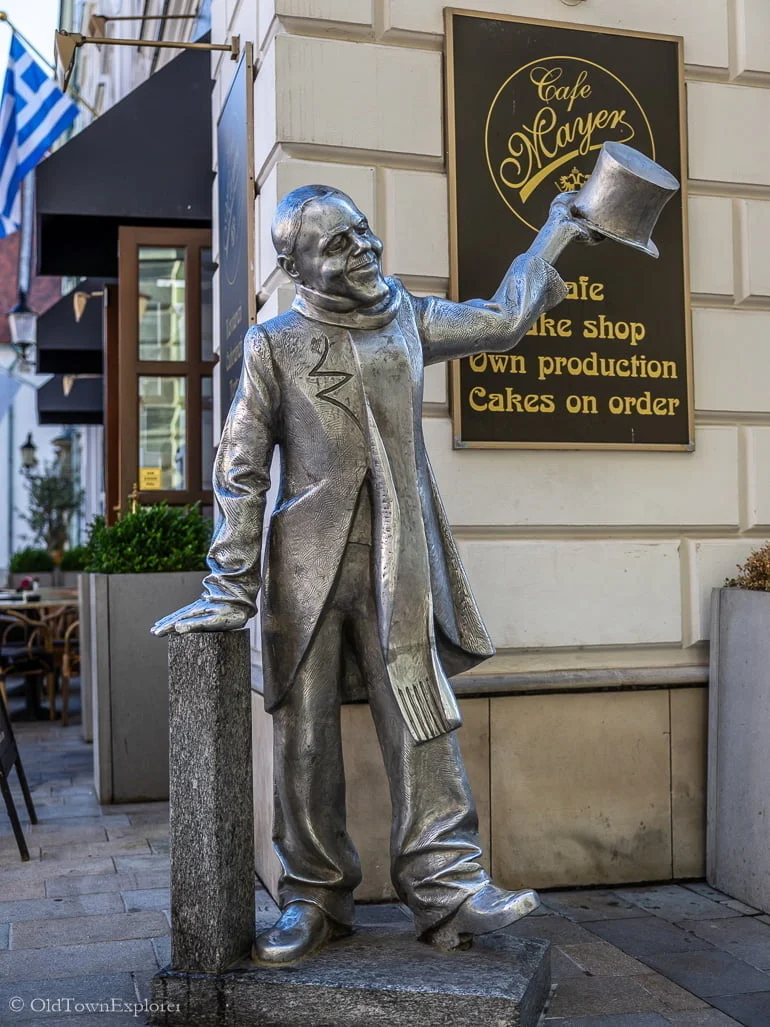
Schöne Náci
The Schöne Náci statue was created by the sculptor Juraj Meliš in 1997 and depicts a real-life person named Ignác Lamár, who was famously known as “Handsome Ignatius” or Schöne Náci. The statue was unveiled to the public when the pedestrian zone around the Old Town Square was reopened.
Address: 355/4 Hlavné námestie, Bratislava, Slovakia
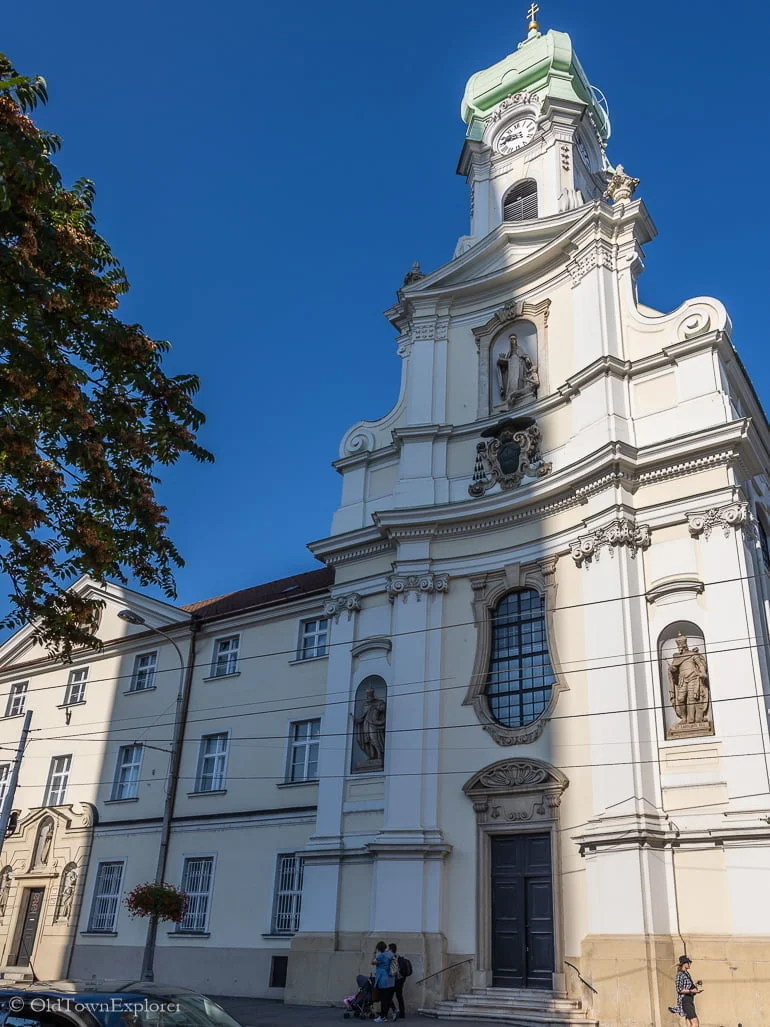
Church of St. Elizabeth of Hungary (Alžbetínky)
St. Elizabeth’s Church was designed by the famous Viennese architect František A. Pilgram and constructed in the Baroque style between 1739 and 1742. Bishop František Zichy consecrated the church in 1743.
The church’s facade is adorned with statues of Hungarian rulers, as well as St. Stefan, St. Ladislav, and St. Elizabeth, which were sculpted by Ľudovít Gode.
Address: Špitálska 21, 811 08 Bratislava, Slovakia
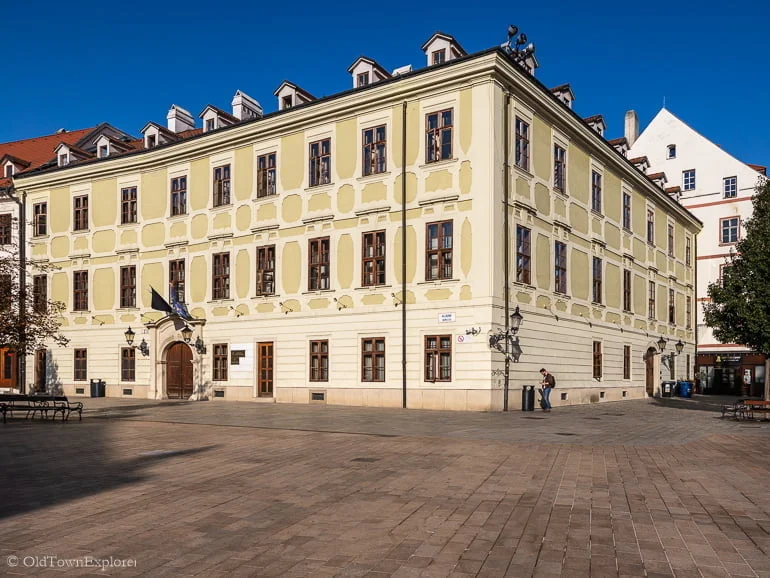
Vice Governor's Palace
The Vice Governor’s Palace (Miestodržiteľský palác) is a historically significant building in the Main Square. The city of Bratislava originally owned the palace. The state later bought it in the 18th century to serve as the residence of The Vice Governor’s Council.
In the aftermath of World War II, the palace was used by various institutions until the Velvet Revolution in 1989. Currently, the building is owned by The Slovak Republic Government and is used mainly for hosting special events.
Address: Radničná 359/8, 811 01 Staré Mesto, Slovakia
Church of Our Lady of Loret
The Church of Our Lady of Loret, also known as Ursuline Church, is a religious building of the Ursuline order in the Old Town. It was built in the Renaissance style and later renovated in the Baroque style from 1659 to 1663. The church has been recognized as a national cultural monument.
Address: Františkánska 1, 811 01 Bratislava, Slovakia

Church of St. Stephan of Hungary
The Church of St. Stephan of Hungary was designed by František Portenhauser in Romanesque Revival style. It was built from 1711 to 1717. In 1735, the church was about to collapse because of weak foundations, but Imrich Eszterházy rebuilt it. In 1737, František Portenhauser expanded the monastery by adding the sacristy and the library.
The church has two side altars painted by Anton Rosier and an Altar of the Holy Cross by Count Karol Zichy. The church’s facade was modified in 1860 by Ignác Feigler. The crypt was repaired between 1867-1895. The monastery deteriorated after the communist regime ended the Capuchins’ activity in 1950. However, after the restoration of freedom, the monastery and the church were extensively renovated.
Address: Župné námestie 10, 811 03 Staré Mesto, Slovakia

Mirbach Palace
The Rococo Mirbach Palace was built between 1768 and 1770 in the Rococo style. It was originally constructed by a brewer named Michael Spech from Bratislava. The palace changed hands several times until Emil Mirbach acquired it. Emil left the palace to the city with the intention of transforming it into a space for the City Gallery. His wish came true, and today, the palace serves as a permanent home for a splendid collection of Gothic paintings on glass, paintings by Holland and Flemish artists, and pieces from Italian artists dating back to the 17th and 18th centuries.
Address: Františkánske námestie 8-11, 811 01 Bratislava, Slovakia
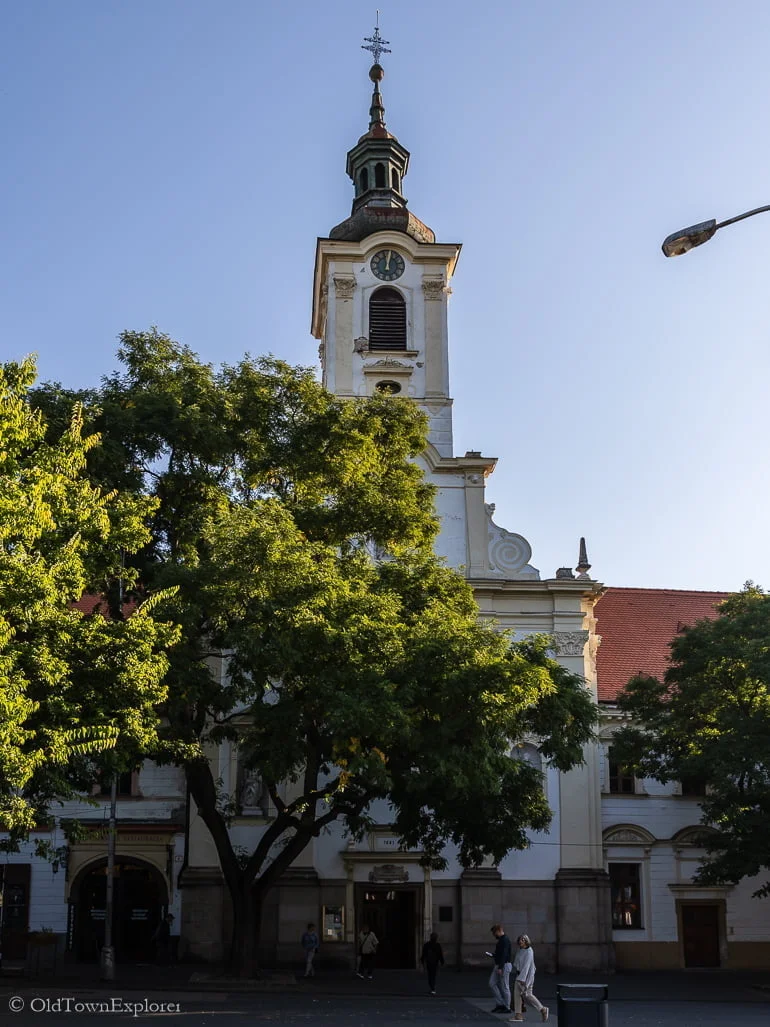
The Church of the Visitation of the Virgin Mary (Merciful Brothers)
Address: Námestie SNP, 811 06 Staré Mesto, Slovakia
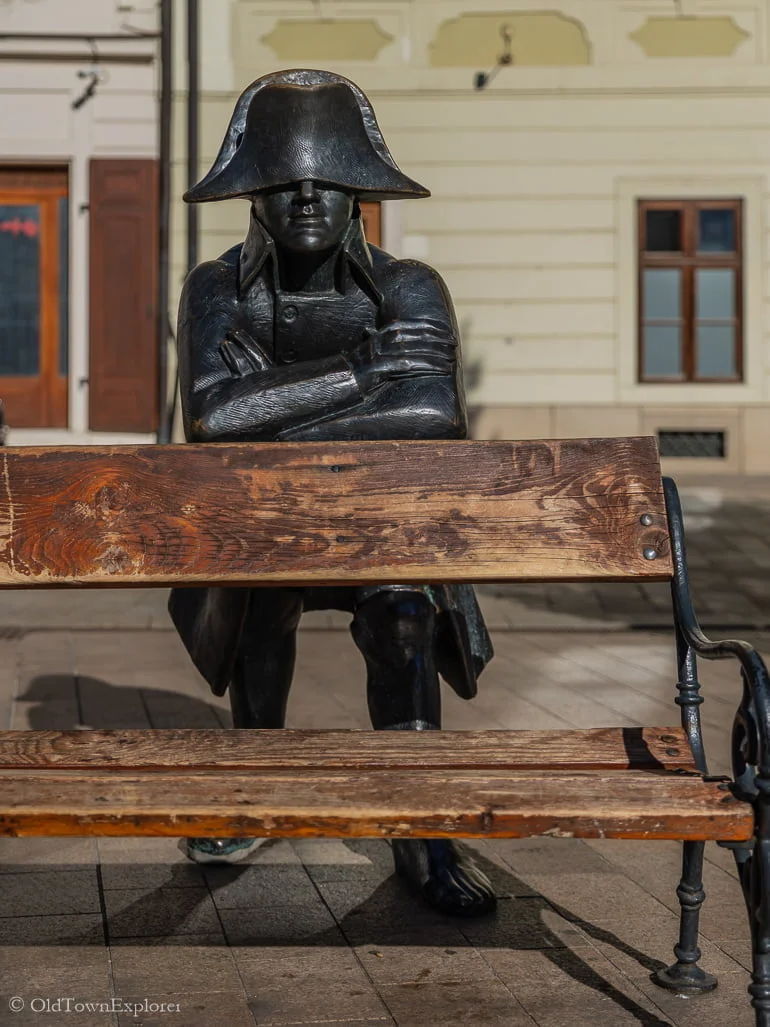
Napoleonic Soldier
The Napoleonic soldier statue located in Old Town Square was created by Juraj Melis in 1997 to commemorate two occasions when Napoleon’s army entered the city. The sculpture depicts a soldier in uniform bending over one of the park benches. According to the local legend, one of Napoleon’s soldiers fell in love with a girl from Bratislava and decided to stay in the city. The statue of a leaning man honors that soldier forever.
Address: Hlavné námestie 358/7, 811 01 Staré Mesto, Slovakia

Blumentálsky Church
The Church of the Assumption of the Virgin Mary, known as Blumentálsky Church, is an eclectic church built between 1885 and 1888 in the Neo-Romance style by architects Friedrich Rumpelmayer and Emil Bressler.
Address: Radlinského, 811 07 Staré Mesto, Slovakia

Fountain of St. George and the Dragon
In the courtyard of the Primatial Palace, there is a beautiful Renaissance fountain that depicts the story of St. George and the dragon. This story is a part of the “Golden Legend,” widely known in early Christian Europe. According to the legend, George was an officer in the Roman army. He arrived at a town that was being terrorized by a dragon. In desperation, the people of the city had to choose victims for the dragon by tossing a coin. Unfortunately, the king’s daughter lost the toss and was about to be devoured by the dragon. But then, George killed the dragon with a spear. Whether George existed or not, he became a symbol of the fight against evil and the victory of Christianity over heathen beliefs.
Address: Primaciálne námestie, 811 01 Staré Mesto, Slovakia

Church of St. Ladislaus
The Church of St. Ladislaus is located on one of the oldest sacral building sites in the city. It was built in 1832 according to the plans of Ignác Feigler. During the foundation stone laying in 1830, the Hungarian monarch Ferdinand V and the Ostrihom archbishop, Cardinal Alexander Rudnay, were present.
The church was restored by Storno in 1891, including the creation of colored windows by Vermes in Šoporn. In 1927, Grünwind, a church painter, filled the interior with figural wall paintings, which suppressed the building’s classicist character. The main altar features a forward canteen with a classic tabernacle, and a large painting of the Apotheosis of Saint Ladislav hangs on the wall. This painting was created by Ferdinand Lütgendorf in 1830.
Address: Špitálska 21, 811 08 Bratislava, Slovakia

Leopold De Pauli’s Palace
Leopold de Pauli’s Palace was built in 1747 by architect Franz K. Romisch as the residence of Count Leopold Pálffy. The Baroque palace boasts a large staircase made of hard Kaiserstein and a garden with a Rococo pavilion. Mozart and Liszt performed here.
From 1993 to 2012, it was the Austrian embassy. Today, the palace is part of the Bratislava University Library.
Address: Ventúrska 263/11, 811 01 Staré Mesto, Slovakia
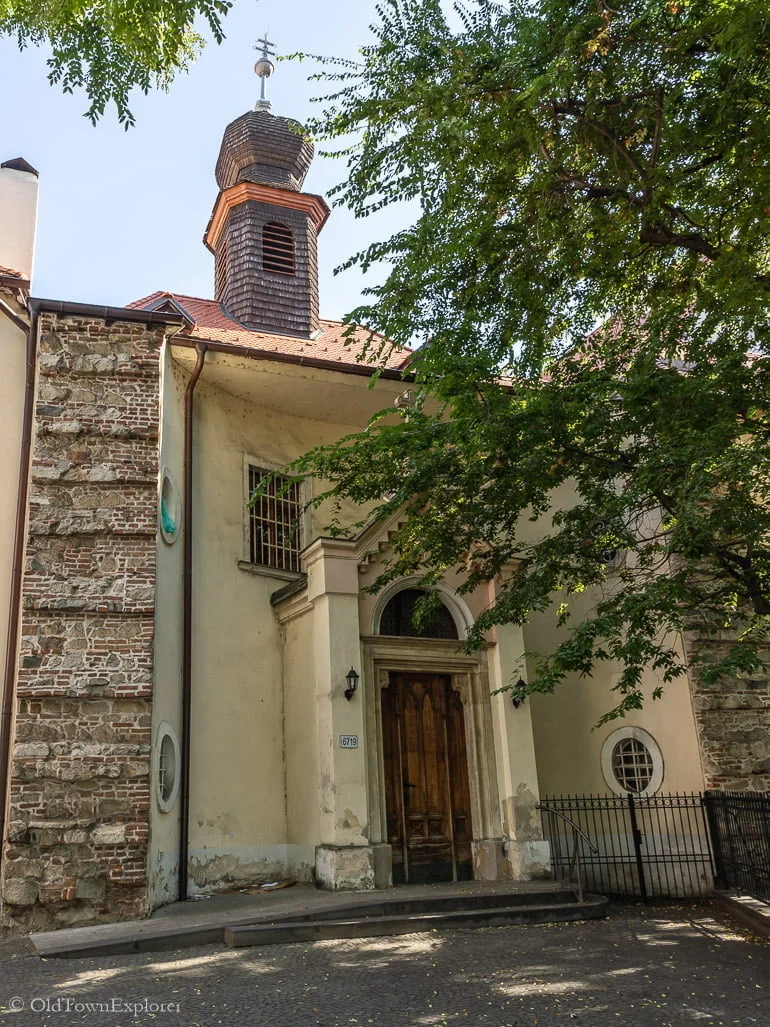
Church of the Assumption of the Virgin Mary (Notre Dame)
The Church of the Assumption of the Virgin Mary, also known as Notre Dame, is a Catholic church built between 1857 and 1866 in the Neo-Classical architectural style. It was commissioned by Jozsef Radocsay, the archbishop of Esztergom. The church is a rectangular building with two stories. It features an elaborate façade and twin steeples. Inside is a large central hall, side chapels, an altar, and a crypt.
During the Communist era in Czechoslovakia, the church was closed and used as a warehouse. Following renovations between 2003 and 2007, it was reopened as a place of worship.
Address: Jesenského 198, 811 02 Bratislava, Slovakia
Slavín
Slavín is a war memorial monument and military cemetery designed by Architect Ján Svetlík. It was opened on April 1, 1960, and serves as a reminder of the city’s liberation by the Soviet Army in April 1945. The memorial is a notable landmark, featuring a central obelisk that stands at more than 39 meters and an 11-meter tall statue of a victorious Soviet soldier carrying a flag. It also serves as the resting place for 6,845 Soviet soldiers who lost their lives during the battles fought for the city and surrounding areas in the final weeks of World War II.
Address: Pažického, 811 04 Staré Mesto, Slovakia

Kern House
Kern House is situated on the corner of Rybárska brána, one of the four entrances to the medieval city, and Hviezdoslavovo Square.
Address: Hviezdoslavovo námestie 225/26, 811 02 Staré Mesto, Slovakia
If you’re still on the fence after reading about the 33 Best Things to See, check out “Is Bratislava Worth Visiting.” We review a long list of factors you should consider before reserving a room and booking your flight.
Bratislava Walking Tour
If you have only one day in Bratislava, we recommend visiting the Old Town in the morning and the area between the Blue Church and the Bratislava Castle in the afternoon.
Old Town
We recommend you start the day with a walking tour in the Old Town. Following is a suggest itinerary:
- Michael’s Tower
- Church of the Annunciation
- Mirbach Palace
- Church of Our Lady of Loret
- Primacial Palace
- Fountain of St. George and the Dragon
- Old Town Hall
- Church of the Most Holy Savior
- Vice Governor’s Palace
- Napoleonic Soldier
- Maximilian Fountain
- Palace of the Hungarian Exchange Bank
- Schöne Náci
- Apponyi Palace
- Rubberneck (Čumil)
- Kern House
- Slovak National Theatre
- Church of the Assumption of the Virgin Mary (Notre Dame)
- Reduta
- St. Martin’s Cathedral
- Leopold De Pauli’s Palace
- Church of the Elevation of the Holy Cross
Outside the Old Town
After lunch, we suggest visiting the following sites in the suggested order:
Following the suggested itinerary will take you past 31 of the Best Things to See in Bratislava and through most of the Old Town. Depending on your level of urgency, you could complete the morning walking tour of the Old Town in less than 2 hours. The afternoon walking tour will take about the same time or just a little longer. These estimates allow time to stop for photos and take a peak inside the churches, but it does not include tours or museum visits.
We suggest you spend an hour or so visiting the Bratislava City Museum in the Old Town Hall and an hour or so seeing the Museum of History in Bratislava Castle. So, if you start at 9:00 a.m. and have a quick lunch, you could be done in time to have a glass of wine by 5:00!
There are two things to see that are not on the walking tour: Slavín and Blumentálsky Church. These attractions are well worth visiting but are not located near the other attractions.
City Tours in Bratislava
Want to learn about the history of Brasov with a guide? Book a highly-rated city tour while visiting Brasov!
One Day in Bratislava
What to do in Bratislava for 1 day?
If you have only one day in Bratislava, we have the perfect itinerary. See Bratislava Walking Tour.
Start your day by exploring the charming Old Town. Take a leisurely walk through its narrow streets and soak in the rich history and architectural beauty surrounding you.
After enjoying a delicious lunch at one of the local eateries, head towards the Blue Church. This unique architecture is a must-see, with its vibrant blue exterior standing out against the surrounding buildings. Take some time to appreciate its beauty and learn about its fascinating history.
As you continue your exploration, make your way to Bratislava Castle. Perched high on a hill, this ancient fortress offers breathtaking views of the city and the Danube River. Step inside and delve into the Museum of History, where you can uncover the stories and artifacts that shaped Bratislava’s past.
To end your day on a tranquil note, stroll along the banks of the Danube River. Take in the peaceful atmosphere and enjoy the scenic views of the city skyline reflecting on the water. If you have time, consider taking a relaxing river cruise to appreciate the beauty of Bratislava from a different perspective fully.
Bratislava Information and Travel Tips
Hotels in Bratislava
If you are planning a trip to Bratislava, there are plenty of excellent places to stay. However, for the best experience, we strongly recommend staying in the Old Town. The castle marker on the map below is the heart of the Old Town. We suggest staying as close to it as possible, depending on your budget and preferences.
The below interactive map provides hotel and apartment options that can be filtered to meet your needs. Select your travel dates to get specific availability and prices.
Book your stay now!
Best Cellular for a Bratislava visit?
Do you need cellular data during your trip and don’t want to pay for roaming? We use eSIMs from Airalo during our travel and highly recommend them. They are cheap, easy to set up, and allow you to leave your primary sim card in your phone (so you don’t lose it). Click below for more info.
Where is Bratislava?
Bratislava is a city located in the southwestern region of Slovakia. It is situated at the base of the Little Carpathians and spans across both banks of the River Danube and the left bank of the River Morava.
FAQs About Best Things to See in Bratislava
What is Bratislava best known for?
Bratislava, the capital city of Slovakia, is best known for its rich history, beautiful architecture, and vibrant cultural scene. Here are some of the highlights:
1. Historic Old Town: Bratislava’s Old Town is a maze of narrow streets and charming squares, lined with colorful buildings and historical landmarks such as Bratislava Castle and St. Martin’s Cathedral.
2. Bratislava Castle: Sitting on a hill overlooking the city, Bratislava Castle is an iconic symbol of the city. It offers panoramic views of the Danube River and the surrounding area.
3. Devin Castle: Located just outside the city, Devin Castle is a medieval fortress that stands at the confluence of the Danube and Morava rivers. It offers stunning views and a glimpse into Slovakia’s past.
4. The Blue Church: Also known as St. Elizabeth’s Church, this Art Nouveau masterpiece is famous for its blue façade and unique design.
5. Local Cuisine: Bratislava is known for its delicious food and drink, including traditional dishes like bryndzové halušky (potato dumplings with sheep cheese) and local wines from nearby vineyards.
These are just a few examples of what Bratislava has to offer. Whether you’re interested in history, culture, or adventure, Bratislava has something for everyone.
Is there anything to see in Bratislava?
Bratislava is a city full of sights and attractions waiting to be explored. Here are some of the things to see in Bratislava:
1. Michael’s Gate: This iconic gate is the only preserved medieval entrance to the city. Climb to the top for panoramic views of Bratislava.
2. Slovak National Theatre: Don’t miss a chance to catch a performance at this beautiful theater, showcasing opera, ballet, and drama.
3. Old Town Hall: Explore the historic heart of Bratislava at the Old Town Hall. Climb the tower for panoramic views and visit the Museum of City History to learn about the city’s past.
4. Grassalkovich Palace: Visit the official residence of the President of Slovakia and admire its beautiful gardens. You might even catch a glimpse of a ceremonial changing of the guards.
5. Bratislava Castle: Discover the grandeur of Bratislava Castle, perched on a hill overlooking the city. Explore its luxurious interior and visit the Slovak National Museum housed within.
6. St. Martin’s Cathedral: Marvel at the stunning Gothic architecture of St. Martin’s Cathedral, where Hungarian kings were crowned. Don’t miss the chance to climb to the top for a bird’s-eye view of the city.
For more, see our list of Best Things to See in Bratislava above.
Is Bratislava Slovakia worth visiting?
Bratislava, the capital of Slovakia, is definitely worth visiting. With its rich history, charming old town, and stunning architecture, Bratislava offers a unique and authentic European experience. You can explore the cobbled streets of the old town, visit iconic landmarks such as Bratislava Castle and St. Martin’s Cathedral, and enjoy panoramic views of the city from the UFO Observation Deck.
Additionally, Bratislava has a vibrant cultural scene, with numerous museums, galleries, and theaters to explore. Whether you’re interested in history, art, or simply soaking up the local atmosphere at one of the city’s many cafes or restaurants, Bratislava has something for everyone.
Is 1 day enough to see Bratislava?
While Bratislava is a charming city with plenty to offer, it is also relatively compact, making it possible to see the main highlights in just one day. Some must-see attractions include the Bratislava Castle, St. Martin’s Cathedral, Old Town Hall, and the iconic UFO Observation Deck. You can also stroll through the picturesque streets of the Old Town, stopping at local cafes and shops along the way. If time permits, consider taking a boat ride along the Danube River to enjoy beautiful city views. Just make sure to plan your itinerary wisely and prioritize the attractions that interest you most.
Is Vienna or Bratislava better?
Both Vienna and Bratislava offer unique experiences and have their own charm. Vienna is known for its rich history, stunning architecture, and vibrant cultural scene. It’s home to numerous museums, palaces, and music venues, making it a popular destination for art and music enthusiasts.
Bratislava, on the other hand, has a more laid-back atmosphere with its charming Old Town, castle overlooking the Danube River, and affordable prices. It’s a great option for those looking for a smaller-scale city with a mix of history and modernity. Ultimately, the choice between Vienna and Bratislava depends on your personal preferences and what you’re looking to experience during your visit.


